Tender Trends: Then and Now chronicles the evolution of the procurement process — from its early days of materials ordering to its rise in shaping policy implementation, industry innovation and social change. Tender Trends: Then and Now is written by bid management veteran and Bidhive CEO Nyree McKenzie who has dedicated more than half her life to the profession.
In this first chapter we begin with an overview of where procurement all began, and its adoption in corporate sales.
Preface
My first major bid kept me awake and working for 36 hours straight. It was an Expo bid submission for the government and one that was a poorly-planned, last minute decision. The bid team was in secure lockdown over the weekend and my parents brought me meals to keep me going. It was exciting to be part of something so high profile and secret. I was hooked.
Despite the obvious breach of government workplace health and safety rules, I worked around the clock without breaks to nurture that Bid all the way through to production and out the other side of the printing despatch room (it was the first digitally printed document to be printed by the government on the newly minted Digital E-Print 1000). I proudly placed the glossy document in a leather presentation folder where it would make its way to Qantas cargo and to its onward journey into the hands of the decision committee in Paris.
The government didn’t win that bid. It was rumoured to have been awarded to a city in Asia that failed to find funding. After declaring insolvency it went to the runner up. The Master Plan for our bid had earmarked a massive corridor of land that was to be developed through compulsory acquisition. I was secretly thankful that the unsuspecting residents were able to keep their homes.
The integrity of the public bidding process across the world has not been without controversy. Probity, like many rules that discourage bad behaviour, can only be as successful as the social and ethical values that humans uphold, or the temptations they reject. For example, in one ‘kick-off meeting’ I overhead that a $10,000 budget was to be assigned to a friend of the Mayor as an incentive payment. In another tender, I learned that a ‘consultant’ on the bid team was actually hired from the procurement side to reveal inside secrets.
For a junior bidder like me who had no career mentors at the time I had no clue that this was not above board until they became public many years later, resulting in jail time for the offenders.
Indeed, bidding for outsourced contracts has seen twists and turns that many industry veterans would have traversed. I’ve worked on a diverse range of bids — from federal government counter-terrorism response to major infrastructure; to program design for child protection and family and domestic violence programs; to procurement of luxury yachts for the transportation of offshore oil and gas workers and the ‘entertainment’ of dignitaries.
Long term trends are easier to identify, while others are still being played out based on past successes and failures of the bidding process, and contracting experiences. Tender Trends: Then and Now chronicles the market developments of a practice that rose to the mainstream after the global financial crisis in response to social, economic and technical pressures to become more effective and efficient. Today, it’s the most used method for large enterprise and public sector procurement.
The procurement and bidding process – an arm’s length method of selecting and entering into a contract for the supply of high value goods, services or works – has ridden the wave of scandals — some more salacious than others — and helped spur on the merry-go-round of reform that keeps procurement hot on contractors’ heels and bid managers forever on their toes.
While the tender process is considered by many to be dry, boring and laborious, the story of its evolution, and the impact of competitive bidding on modern business operations and structures, and how ideas are found and solutions engineered that shape cities, communities and social policies, is worth sharing.
If you’ve ever responded to a tender you may relate to being locked away (or you know someone who has) in a back room preparing your response in the early hours, over the weekend, and on your (cancelled) holidays. Gluttons for punishment with pressure and unforgiving deadlines unite us.
Working under these conditions was never unfamiliar to me. I worked for the family business, which was an industrial auctioneering company specialising in mining and heavy equipment. My job was to be the ‘Girl Friday’ and assist with the pre-marketing campaigns – a role that kept me gainfully employed from the time I was 12 years old. After completing a business degree in public relations and later a Master of Business in Marketing I continued to help the business with project marketing proposals for appointment by the banks, and as my career progressed I was regularly assigned as the ‘proposal writer’ within the marketing team wherever I worked.
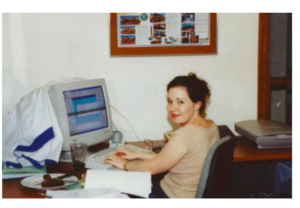 Above: Working for the family business (source: Simshauser family photo)
Above: Working for the family business (source: Simshauser family photo)
After my memorable experience with the Expo bid I moved into public affairs, business development and communication roles, including management of government-to-government tenders (there’s such a thing!), and a few years later I established my own bid management consultancy working mostly with large corporates seeking public sector contracts. I have sat on both sides of tenders, as an evaluator, and a responder.
Like most bid professionals, I never consciously set out to pursue this career, and no degree would prepare me for the school of hard knocks. The discipline draws upon a mix of business strategy, project management, technical writing and persuasive storytelling, solution design, data analysis, research and evidence gathering, and creative problem solving. Add long document formatting, God speed typing, file taxonomy and naming conventions, curiosity, a love of infographics, policy, legalese and compliance interpretation as well as cat herding. and that just about sums up the job description.
I love bidding and working as a team to create solutions to complex problems. And I’ve made it my life’s work shifting from practitioner to now, a tech entrepreneur on a mission to create a fairer, more transparent system for all businesses. The benefit of having a long career in a field is that you can map the patterns over time. Along the continuum there are shifts in purchasing and procurement predictably influenced by world economic events, social and government policy.
Over time these constant movements affect how organisations and professionals need to adapt and respond to business opportunities in order to remain competitive. And when you look at world events and history, procurement demand will rise when events affect supply. This will invariably create procurement risk, which will then affect confidence, and then markets. This in turn affects what happens in the world of bidding.
When you consider what is happening in the world and apply this theory, the evidence is all there that the system needs to change again. But this time it will unlikely be changed by governments, but by an ecosystem of actors. These actors will be businesses (large and small), governments, non-government organisations, and citizens.
When 5 men have the combined wealth of 75% of the world’s economy there is gross inequality in the distribution of power and wealth. When only two years ago just 10 corporations held over 85% of the contract values of the Federal government spend in Australia there is risk aversion in the distribution of contracts. Yet if procurement is the largest marketplace in the world and SMEs comprised 99.6% of all employer firms doesn’t it make economical sense that procurement and SMEs come together to become a global economic powerhouse?
Imagine the solutions that could come to market faster if we could have a system which had integrity of design to maintain transparency and fight corruption, but which worked more fluidly along the supply chain to unlock talent and ideas without traditional red tape or institutional bias.
Imagine a system where SMEs – which are closer to their communities and can bring ideas to market quickly – could work with government to help solve global problems, locally. Imagine the ideas or human talent that could revolutionise an industry that could be unlocked if there was a platform to facilitate discovery and matching across a diverse and inclusive ecosystem? Imagine a system where small and large business can work together to create and build something brilliant based on exceptional product or solution/market fit and the excitement of discovering you can potentially solve a problem 100 times faster than previously when you only worked with your narrow supplier-base of ‘mates’?
These are the every day stories of businesses that could have the next big thing – or just the next project – to keep their businesses and our world economy going, and growing. It’s what I imagine the world to be soon.
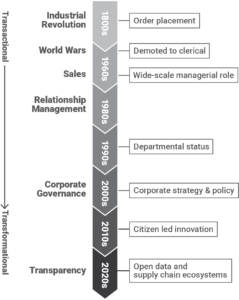
Above: The evolution of purchasing and procurement mirrors the backdrop of external influences (source: Nyree McKenzie).
Tender Trends: Then and Now chronicles the market developments of a practice that rose to the mainstream after the global financial crisis in response to social, economic and technical pressures to become more effective and efficient. Today, it is the most used method for large enterprise and public sector procurement. It has ridden the wave of scandals — some more salacious than others — and helped spur on the merry-go-round of reform that keeps procurement hot on contractors’ heels and bid managers forever on their toes.
The industrial revolution and the transactional order
While procurement can be traced as far back as Egypt in 3,000 BC when scribes managed the pyramid supply chain, procurement as a profession became more prominent during the industrial revolution in the 1800s, as highlighted in Marshall Kirkman’s 1887 book The Handling of Railway Supplies — Their Purchase and Disposition.
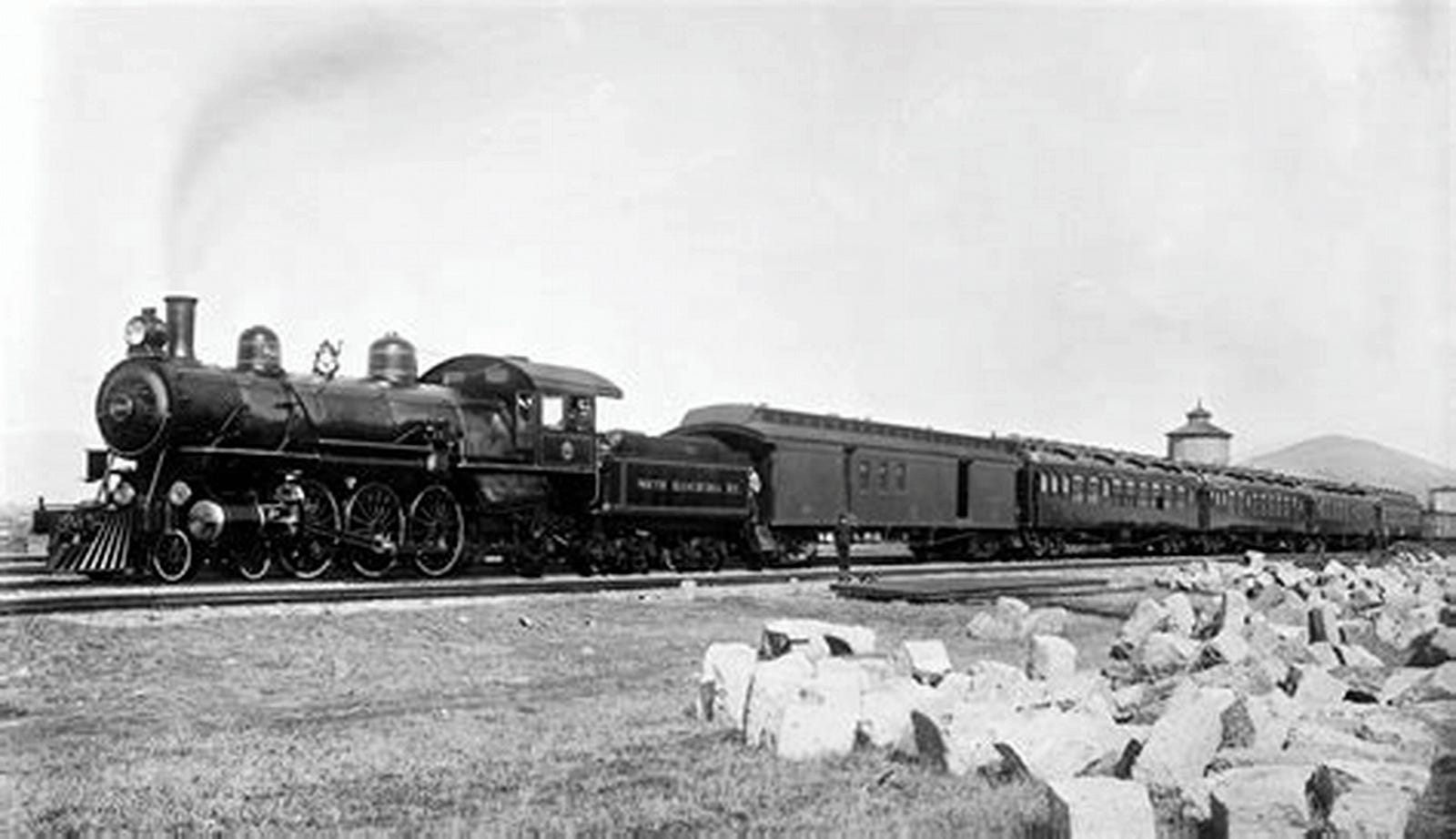
Above: The rail industry and the movement of materials revolutionised procurement in the 1800s
Procurement’s strategic position was soon demoted to a clerical function during the war years when there was a scarcity of materials. At this time procurement revolved mostly around order placement.
1950s — 1960s: The beginning of the sales pitch
It was not until the mid-1960s that procurement once again reclaimed its managerial role on a broader scale. Material management around this time became the focus with procurement professionals embracing price-based competitive bidding for most contracts. An increase in trained sales professionals (including the door-to-door salesperson) during this time helped procurement on its way to regaining departmental status.
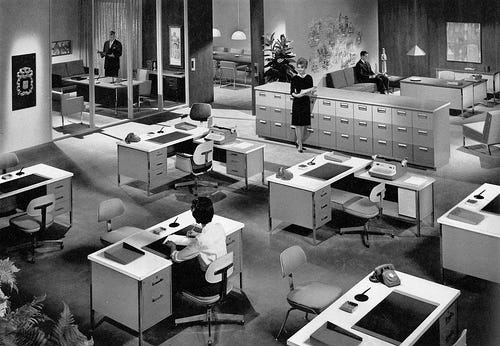
Above: Sales professionals gained departmental status (and a typing pool)
The introduction of key account management in the business-to-business world had much to do with environmental changes (oil crisis, dispersed buyers and growing commoditisation) which forced selling companies to focus less on price, and more on improving their quality and services. This scenario is perfectly played out in Mad Men’s Carousel scene where we are drawn into Don Draper’s use of emotional appeal to nail his advertising pitch with a unique value proposition (USP).
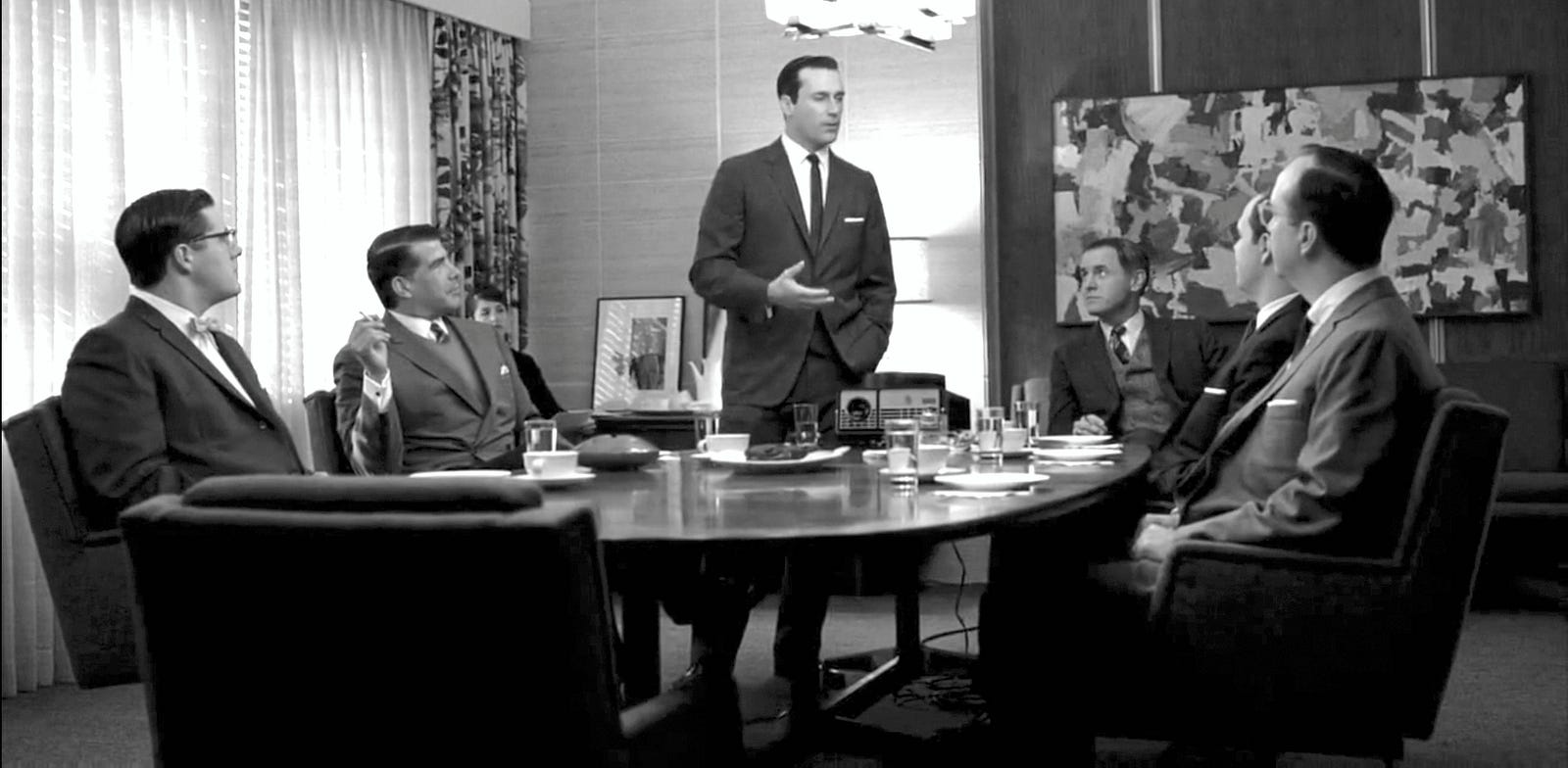
Above: Mad Men’s Don Draper and his storage device pitch to Kodak (watch the video here)
Read more
Tender Trends: Then and Now Chapter 1 – Clerical
Tender Trends: Then and Now Chapter 2 – Corruption and Cost Cuts
Tender Trends: Then and Now Chapter 3 – Collapses and Compliance
Tender Trends: Then and Now Chapter 4 – Chains of Command
Tender Trends: Then and Now Chapter 5 – Citizens






